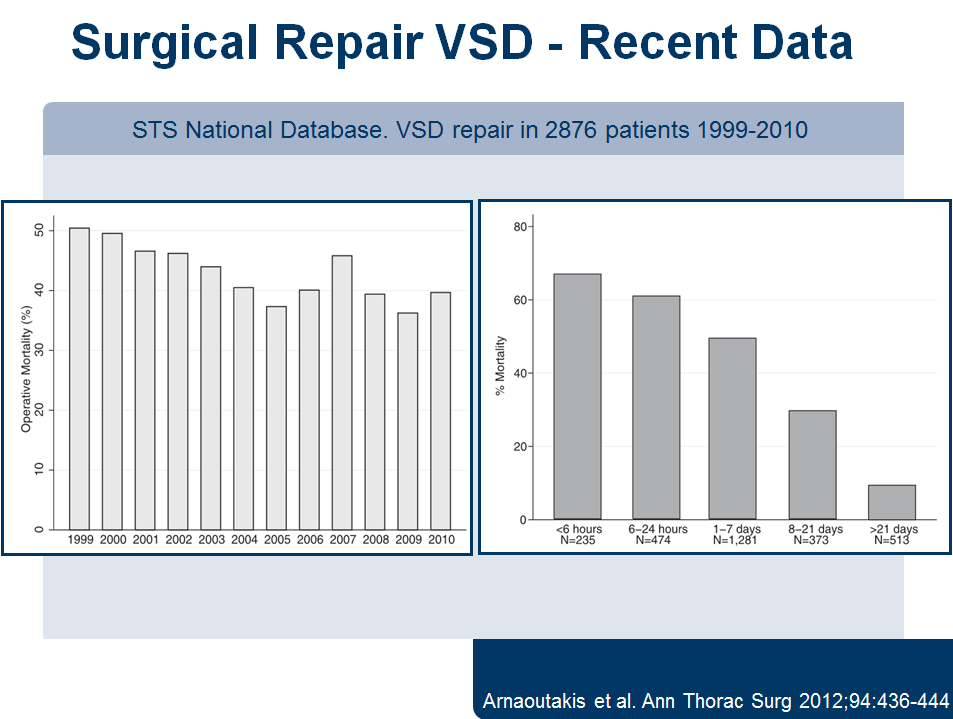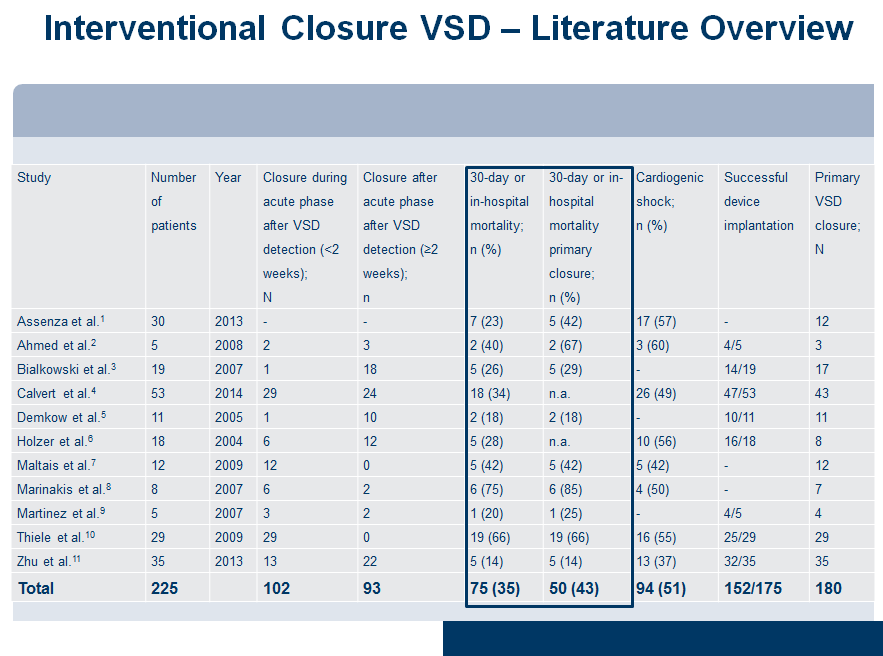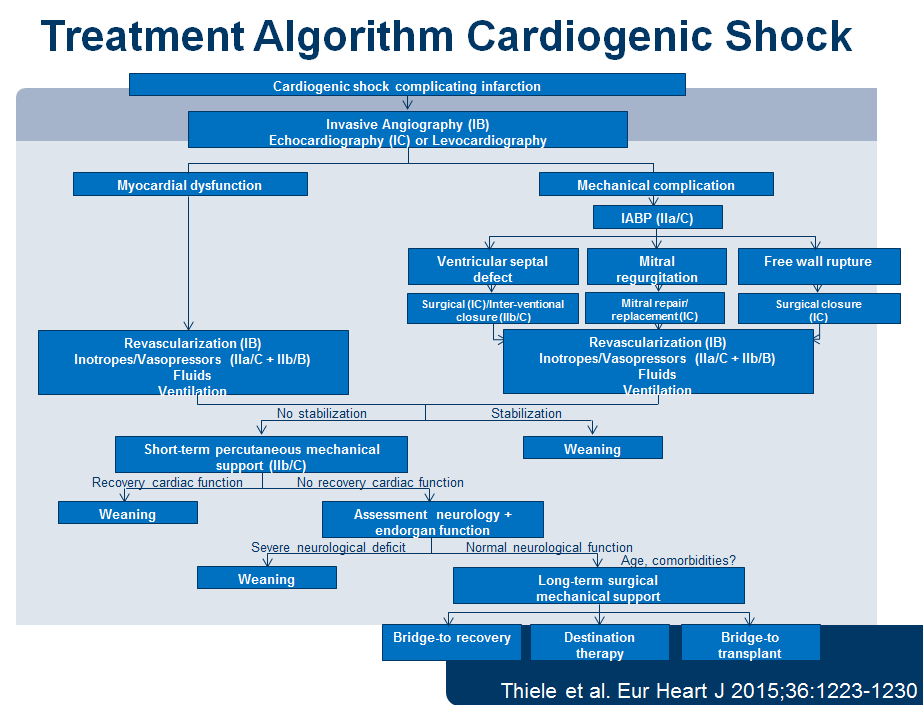How Should We Treat VSDs and Acute MR Post MI?
Ventricular septal defect (VSD) complicating AMI is a relatively rare event associated with high mortality. The incidence of infarct related VSD without reperfusion ranged from 1-2%,1,2 with a decrease to 0.2% in the era of reperfusion.3 In patients with cardiogenic shock, VSD is the underlying cause in 3.9%, and mortality can be as high as 87.3%, as was seen in the SHOCK trial registry.4 Without surgical repair of postinfarction VSD 90% of patients die within 2 months.5
Surgical VSD correction was first described in 1957.6 The current mortality of surgical postinfarction VSD closure is as high as 50%, with a lower mortality seen when surgery is delayed (Slide 1).7 However, the lower mortality from delayed surgery may relate more to selection bias, with survival of the fittest. In two prospective registries, the mortality rates were as high as 81-100% for patients with VSD and shock.3,8 Current guidelines recommend immediate surgical VSD closure irrespective of the patient's hemodynamic status.9,10 Nevertheless, a subgroup of patients with VSD exists for whom surgery is futile, because mortality approaches 100%; this includes the very elderly and patients with poor right ventricular function.
As a result of the high mortality and suboptimal surgical results with a postoperative residual shunt found in up to 20% of the treated patients,3,11,12 the technique of percutaneous VSD device closure has been developed.13 Currently, data are limited for postinfarction VSD interventional closure. The largest single-center experience reported was in 29 patients, which found a survival rate at 30 days of 35%. Mortality was much higher in cardiogenic shock as opposed to non-shock patients (88% versus 38%, p<0.001).13 Procedure related complications were not infrequent, which demonstrates the requirement of additional technical improvement. An overview on outcomes of interventional VSD repair can be found in Slide 2, showing similar mortality rates as compared to surgical repair.
In patients with cardiogenic shock, acute ischemic mitral regurgitation was the underlying cause in 6.9%. In acute ischemic mitral regurgitation, only papillary muscle rupture needs immediate repair. Other causes, such as left ventricular global or regional remodelling, or ischemic papillary muscle dysfunction, may resolve after revascularization and recovery of left ventricular function. Accordingly, only 46% of the patients in the SHOCK trial registry underwent mitral valve surgery.14 In contrast to VSD repair, surgery of papillary muscle rupture does not involve necrotic myocardium in suture lines. Therefore, mortality associated with this repair is lower, although is still high with an overall mortality of 55%.4,14 Nevertheless, the unpredictability and potential for rapid deterioration and death with papillary muscle rupture makes early surgery necessary. There are few case reports with interventional edge-to-edge repair in acute ischemic mitral regurgitation; however, no larger series have been published. A treatment algorithm with the underlying guideline recommendations for the assessment and treatment of patients with cardiogenic shock and potential mechanical complications has recently been published and may be a helpful tool in clinical practice.15
|
References
- Heitmiller R, Jacobs ML, Daggett WM. Surgical management of postinfarction ventricular septal rupture. Ann Thorac Surg 1986; 41:683-691.
- Topaz O, Taylor AL. Interventricular septal rupture complicating acute myocardial infarction: from pathophysiologic features to the role of invasive and noninvasive diagnostic modalities in current management. Am J Med 1992; 93:683-688.
- Crenshaw BS, Granger CB, Birnbaum Y, Pieper KS, Morris DC, Kleiman NS, Vahanian A, Califf RM, Topol EJ. Risk factors, angiographic patterns, and outcomes in patients with ventricular septal defect complicating acute myocardial infarction. GUSTO-I (Global Utilization of Streptokinase and TPA for Occluded Coronary Arteries) Trial Investigators. Circulation 2000; 101:27-32.
- Hochman JS, Buller CE, Sleeper LA, Boland J, Dzavik V, Sanborn TA, Godfrey E, White HD, Lim J, LeJemtel T. Cardiogenic shock complicating acute myocardial infarction--etiologies, management and outcome: a report from the SHOCK Trial Registry. J Am Coll Cardiol 2000; 36:1063-1070.
- Lee WY, Cardon L, Slodki SJ. Perforation of infarcted interventricular septum. Report of a case with prolonged survival and review of the literature. Arch Intern Med 1962; 109:731-735.
- Cooley DA, Belmonte BA, Zeis LB, Schnur S. Surgical repair of ruptured interventricular septum following acute myocardial infarction. Surgery 1957; 41:930-937.
- Arnaoutakis GJ, Zhao Y, George TJ, Sciortino CM, McCarthy PM, Conte JV. Surgical repair of ventricular septal defect after myocardial infarction: Outcomes from the Society of Thoracic Surgeons National Database. Ann Thorac Surg 2012; 94:436-444.
- Menon V, Webb JG, Hillis LD, Sleeper LA, Abboud R, Dzavik V, Slater JN, Forman R, Monrad ES, Talley JD, Hochman JS. Outcome and profile of ventricular septal rupture with cardiogenic shock after myocardial infarction: a report from the SHOCK Trial Registry. SHould we emergently revascularize Occluded Coronaries in cardiogenic shocK? J Am Coll Cardiol 2000; 36:1110-1116.
- Steg PG, James SK, Atar D, Badano LP, Lundqvist CB, Borger MA, Di Mario C, Dickstein K, Ducrocq G, Fernandez-Aviles F, Gershlick AH, Giannuzzi P, Halvorsen S, Huber K, Juni P, Kastrati A, Knuuti J, Lenzen MJ, Mahaffey KW, Valgimigli M, Van `t Hof A, Widimsky P, Zahger D. ESC Guidelines for the management of acute myocardial infarction in patients presenting with ST-segment elevation. Eur Heart J 2012; 33:2569-2619.
- Wijns W, Kolh P, Danchin N, Di Mario C, Falk V, Folliguet T, Garg S, Huber K, James S, Knuuti J, Lopez-Sendon J, Marco J, Menicanti L, Ostojic M, Piepoli MF, Pirlet C, Pomar JL, Reifart N, Ribichini FL, Schalij MJ, Sergeant P, Serruys PW, Silber S, Sousa Uva M, Taggart D, Vahanian A, Auricchio A, Bax J, Ceconi C, Dean V, Filippatos G, Funck-Brentano C, Hobbs R, Kearney P, McDonagh T, Popescu BA, Reiner Z, Sechtem U, Sirnes PA, Tendera M, Vardas PE, Widimsky P, Alfieri O, Dunning J, Elia S, Kappetein P, Lockowandt U, Sarris G, Vouhe P, von Segesser L, Agewall S, Aladashvili A, Alexopoulos D, Antunes MJ, Atalar E, Brutel de la Riviere A, Doganov A, Eha J, Fajadet J, Ferreira R, Garot J, Halcox J, Hasin Y, Janssens S, Kervinen K, Laufer G, Legrand V, Nashef SA, Neumann FJ, Niemela K, Nihoyannopoulos P, Noc M, Piek JJ, Pirk J, Rozenman Y, Sabate M, Starc R, Thielmann M, Wheatley DJ, Windecker S, Zembala M. Guidelines on myocardial revascularization: The Task Force on Myocardial Revascularization of the European Society of Cardiology (ESC) and the European Association for Cardio-Thoracic Surgery (EACTS). Eur Heart J 2010; 31:2501-2555.
- Caputo M, Wilde P, Angelini GD. Management of postinfarction ventricular septal defect. Br J Hosp Med 1995; 54:562-566.
- Deja MA, Szostek J, Widenka K, Szafron B, Spyt TJ, Hickey MS, Sosnowski AW. Post infarction ventricular septal defect - can we do better? Eur J Cardiothorac Surg 2000; 18:194-201.
- Thiele H, Kaulfersch C, Daehnert I, Schoenauer M, Eitel I, Borger M, Schuler G. Immediate primary transcatheter closure of postinfarction ventricular septal defects. Eur Heart J 2009; 30:81-88.
- Thompson CR, Buller CE, Sleeper LA, Antonelli TA, Webb JG, Jaber WA, Abel JG, Hochman JS. Cardiogenic shock due to acute severe mitral regurgitation complicating acute myocardial infarction: a report from the SHOCK Trial Registry. J Am Coll Cardiol 2000; 36:1104-1109.
- Thiele H, Ohman EM, Desch S, Eitel I, de Waha S. Management of cardiogenic shock. Eur Heart J 2015; 36:1223-1230.
Keywords: Aged, Algorithms, Cardiac Surgical Procedures, Heart Septal Defects, Ventricular, Hemodynamics, Incidence, Mitral Valve, Mitral Valve Insufficiency, Myocardial Infarction, Papillary Muscles, Prospective Studies, Registries, Selection Bias, Shock, Shock, Cardiogenic, Survival Rate, Sutures, Ventricular Function, Left, Ventricular Function, Right, Acute Coronary Syndrome
< Back to Listings



